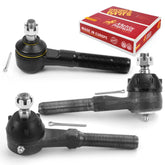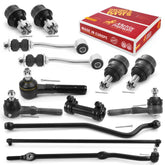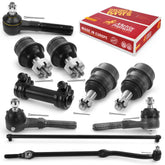Auto Tech: Past, Present, Future
Past Technologies and Evolution:

Steering:
The evolution of the automobile steering system can be traced back to the early 20th century when the steering wheel was introduced. Before that, direct manual steering systems were used, which often featured a tiller. However, with the introduction of the steering wheel, a more familiar and ergonomic interface was provided to the drivers.

In the mid-20th century, mechanical linkages such as recirculating ball and worm and sector gear mechanisms became common for translating the steering wheel input to wheel movement. These systems greatly improved the steering control and precision.
Later, in the same century, hydraulic power steering systems were introduced, which significantly reduced the effort required to turn the wheel, enhancing driver comfort. These power steering systems were a pioneer and are still widely used in modern automobiles.
From the tiller to the power steering system, the evolution of steering systems has come a long way. The modern-day steering systems are not only more comfortable and convenient but also more reliable and safer.

Suspension:
The evolution of suspension systems has been fascinating in the automobile industry. In the early days of automobiles, basic suspension systems featured leaf springs and solid axles, which offered minimal shock absorption. However, with the adoption of independent front suspension in the 1930s, ride comfort and handling improved significantly.

The integration of hydraulic shock absorbers in the mid-20th century helped to reduce oscillations and improve stability. Advanced suspension geometries like MacPherson struts and multi-link setups were then introduced in the late 20th century, further improving handling characteristics.
Car suspension systems ensure safety and comfort while driving. They have evolved, providing better handling and smoother rides for drivers and passengers alike.

Steering and Suspension Systems Challenges:
The development of steering and suspension systems for vehicles has been a continuous process, with several challenges and concerns to tackle. One of the primary issues has been the weight and size of these systems, which were initially bulky and heavy. This affected the overall performance and fuel efficiency of the vehicle.

Another significant challenge has been achieving a balance between ride comfort and precise handling. Suspension systems must absorb road irregularities while maintaining stability during cornering, which requires careful design and testing.
Ensuring safety has been a major focus during the creation of steering and suspension components, specifically for instances of high stress such as sudden braking or swerving. Consistent enhancements to materials and design have contributed to the safety of these systems.

Power steering systems have enhanced ease of use and also introduced additional complexity. This complexity can make it more challenging to diagnose and repair issues. That is why it's essential to have a qualified mechanic perform any necessary maintenance or repairs.
Evolution Leading to Current Technologies:
The adoption of electronic control systems (like Electronic Stability Control (ESC)) has transformed the automotive industry. These systems provide dynamic adjustments in steering and suspension, based on driving conditions, and ensure a safer, more stable ride.
Material advancements have improved the efficiency and durability of steering and suspension components. One of the examples is the use of lightweight and high-strength materials like aluminum and composite materials,
The introduction of active suspension systems has also contributed to improved ride quality and handling performance, as these advanced systems can adjust damping rates in real-time.
Additionally, Electric Power Steering (EPS) systems are more flexible, efficient, and make steering easier and precise.
Today's Automotive Steering and Suspension Systems Challenges:
As the automotive industry evolves, steering and suspension systems face several challenges. These challenges expect careful attention and innovative solutions. Firstly, with the increasing trend toward autonomous driving, it is essential to develop systems that can adapt to the unique demands of self-driving cars, where human input may be minimal or nonexistent.

Designing steering and suspension systems that can accommodate the specific characteristics of electric drivetrains, such as weight distribution and energy recovery during braking, is presenting new challenges in the shift towards electric vehicles.
The blend of materials requires careful engineering to ensure compatibility, durability, and cost-effectiveness, such as traditional metals and advanced composites. Also, cybersecurity concerns have become a crucial consideration to prevent unauthorized access or tampering, as electronic control systems become more integrated.
For steering and suspension components, meeting sustainability goals requires the development of eco-friendly materials and manufacturing processes. With these challenges in mind, it is essential to invest in research and development to ensure that steering and suspension systems can keep up with the rapid pace of innovation in the automotive industry.

As the automotive industry moves towards autonomous driving and electric vehicles, the challenges faced by steering and suspension systems have become more complex. Therefore, it is crucial to develop systems that can adapt to these unique demands and accommodate the specific characteristics of electric drivetrains.
It is also important to consider the mix of materials, including traditional metals and advanced composites, while designing these systems to ensure optimal performance and efficiency. Prioritizing safety and reliability is essential in the development of steering and suspension components to provide a safer and more enjoyable driving experience.
The automotive industry must embrace these challenges and innovate further to create more advanced and efficient steering and suspension systems that can provide a seamless and enjoyable driving experience while ensuring the safety and well-being of drivers and passengers. Metrix Premium Chassis Parts continuously researches and applies the best solution to the needs with technological improvements.
Join us on Instagram For More Tips!









